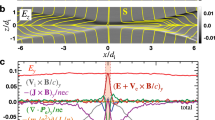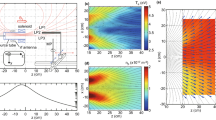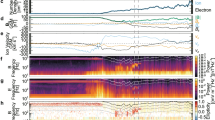Abstract
Magnetic reconnection has a crucial role in a variety of plasma environments1,2,3 in providing a mechanism for the fast release of stored magnetic energy. During reconnection the plasma forms a ‘magnetic nozzle’, like the nozzle of a hose, and the rate is controlled by how fast plasma can flow out of the nozzle. But the traditional picture of reconnection has been unable to explain satisfactorily the short timescales associated with the energy release, because the flow is mediated by heavy ions with a slow resultant velocity. Recent theoretical work4,5,6 has suggested that the energy release is instead mediated by electrons in waves called ‘whistlers’, which move much faster for a given perturbation of the magnetic field because of their smaller mass. Moreover, the whistler velocity and associated plasma velocity both increase as the ‘nozzle’ becomes narrower. A narrower nozzle therefore no longer reduces the total plasma flow—the outflow is independent of the size of the nozzle. Here we report observations demonstrating that reconnection in the magnetosphere is driven by whistlers, in good agreement with the theoretical predictions.
This is a preview of subscription content, access via your institution
Access options
Subscribe to this journal
Receive 51 print issues and online access
$199.00 per year
only $3.90 per issue
Buy this article
- Purchase on Springer Link
- Instant access to full article PDF
Prices may be subject to local taxes which are calculated during checkout



Similar content being viewed by others
References
Paschmann, G. et al. Plasma acceleration at the earth’s magnetopause: Evidence for reconnection. Nature 282, 243–246 (1979).
Priest, E. R. Solar Flare Magnetohydrodynamics (Gordon & Breach, London, 1981).
Urrutia, J. M., Stenzel, R. L. & Rousculp, C. L. Pulsed currents carried by whistlers. III. Magnetic fields and currents excited by an electrode. Phys. Plasmas 2, 1100–1113 (1995).
Drake, J. F., Biskamp, D. & Zeiler, A. Breakup of the electron current layer during 3-D collisionless magnetic reconnection. Geophys. Res. Lett. 24, 2921–2924 (1997).
Birn, J. et al. GEM magnetic reconnection challenge. J. Geophys. Res. (in the press).
Shay, M. A., Drake, J. F., Rogers, B. N. & Denton, R. E. The scaling of collisionless magnetic reconnection for large systems. Geophys. Res. Lett. 26, 2163–2166 (1999).
Mandt, M. E., Denton, R. E. & Drake, J. F. Transition to whistler mediated magnetic reconnection. Geophys. Res. Lett. 21, 73–76 (1994).
Le, G. & Russell, C. T. The thickness and structure of high beta magnetopause current layer. Geophys. Res. Lett. 21, 2451–2454 (1994).
Lee, L. C. & Fu, Z. F. A theory of magnetic flux transfer at the Earth’s magnetopause. Geophys. Res. Lett. 12, 105–108 (1985).
Shay, M. A., Drake, J. F., Rogers, B. N. & Denton, R. E. Alfvenic collisionless magnetic reconnection and the Hall term. J. Geophys. Res. (in the press).
Sonnerup, B. U. O. in Solar System Plasma Physics (eds Lanzerotti, L. J., Kennel, C. F. & Parker, E. N.) Vol. 3, 45–108 (North-Holland, Amsterdam, 1979).
Drake, J. F., Kleva, R. G. & Mandt, M. E. Structure of thin current layers: Implications for magnetic reconnection. Phys. Rev. Lett. 73, 1251–1254 (1994).
Anderson, R. R. et al. Plasma waves near the magnetopause. J. Geophys. Res. 87, 2087–2107 (1982).
Petshek, H. E. in AAS__NASA Symposium on the Physics of Solar Flares (ed. Hess, W. N.) 425–439 (NASA Spec. Publ. SP-50, Washington DC, 1964).
Matsumoto, H. et al. Plasma wave observations with GEOTAIL spacecraft. J. Geomagn. Geoelectr. 46, 59–95 (1994).
Zhu, Z. et al. The relationship between ELF-VHF waves and magnetic shear at the dayside magnetopause. Geophys. Res. Lett. 23, 773–776 (1996).
Song, P. et al. Properties of ELF emissions in the dayside magnetopause. J. Geophys. Res. 103, 26495–26506 (1998).
Hesse, M., Schindler, K., Birn, J. & Kuznetsova, M. The diffusion region in collisionless magnetic reconnection. Phys. Plasmas 5, 1781–1795 (1999).
Pritchett, P. L., Coroniti, F. V. & Decyk, V. K. Three-dimensional stability of thin quasi-neutral current sheets. J. Geophys. Res. 101, 27413–27429 (1996).
Russell, C. T. & Elphic, R. C. ISEE observations of flux transfer events at the dayside magnetopause. Geophys. Res. Lett. 6, 33–36 (1979).
Acknowledgements
We thank H. Kojima, J. F. Drake and R. R. Anderson for their help and valuable discussion, and T. Mukai and N. Nagai for providing the particle and magnetic field data, respectively. D.X.H. is on leave from Wuhan University and received support from the RASC Visiting Foreign Scientist programme. This work was supported by a Grant-in-Aid for Scientific Research.
Author information
Authors and Affiliations
Corresponding author
Rights and permissions
About this article
Cite this article
Deng, X., Matsumoto, H. Rapid magnetic reconnection in the Earth’s magnetosphere mediated by whistler waves. Nature 410, 557–560 (2001). https://doi.org/10.1038/35069018
Received:
Accepted:
Issue Date:
DOI: https://doi.org/10.1038/35069018
This article is cited by
-
Recent progress on magnetic reconnection by in situ measurements
Reviews of Modern Plasma Physics (2023)
-
Direct observations of pure electron outflow in magnetic reconnection
Scientific Reports (2022)
-
Kinetic properties of collisionless magnetic reconnection in space plasma: in situ observations
Reviews of Modern Plasma Physics (2022)
-
Kinetic Alfven wave (KAW) eigenmode in magnetosphere magnetic reconnection
Reviews of Modern Plasma Physics (2022)
-
Origin of two-band chorus in the radiation belt of Earth
Nature Communications (2019)
Comments
By submitting a comment you agree to abide by our Terms and Community Guidelines. If you find something abusive or that does not comply with our terms or guidelines please flag it as inappropriate.



